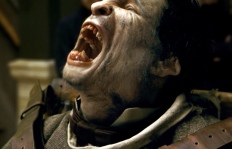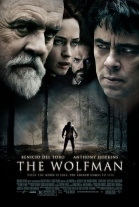The Wolfman
 | The Wolfman |
|  There is something primal in the enduring appeal of the Universal stable of Gothic-inspired monsters--Dracula, Frankentein’s monster, the Invisible Man, the Mummy, and the Wolf Man--which were introduced to movie audiences in the 1930s and helped to cement horror, which up until then had been a relatively amorphous concept, into a lasting cinematic genre. Those monsters quickly buried themselves deep into the cinematic psyche, where they have resided ever since, emerging now and again in various guises, but always bringing with them the same fundamental fears of monstrosity, divided selves, and the fury of nature betrayed. Even after being turned into shambling jokes in Abbott and Costello comedies of the ’40s and ’50s, these monsters endured with the promise of continual reinvention. There is something primal in the enduring appeal of the Universal stable of Gothic-inspired monsters--Dracula, Frankentein’s monster, the Invisible Man, the Mummy, and the Wolf Man--which were introduced to movie audiences in the 1930s and helped to cement horror, which up until then had been a relatively amorphous concept, into a lasting cinematic genre. Those monsters quickly buried themselves deep into the cinematic psyche, where they have resided ever since, emerging now and again in various guises, but always bringing with them the same fundamental fears of monstrosity, divided selves, and the fury of nature betrayed. Even after being turned into shambling jokes in Abbott and Costello comedies of the ’40s and ’50s, these monsters endured with the promise of continual reinvention.Over the past 20 years each of the Universal monsters has been given a Hollywood big-screen resurrection, some more successful than others. It began in 1992 with Francis Ford Coppola’s opulent Bram Stoker’s Dracula, which was as much a love letter to silent film trickery and stage theatrics as it was a horror film. Kenneth Branagh followed two years later with Mary Shelley’s Frankenstein (1994), a literate and underrated attempt to take the Frankenstein myth closer to its literary source. Stephen Sommers successfully reinvented The Mummy as a blockbuster Indiana Jones-style thrill-ride in 1999 (with sequels following in 2001 and 2008) and not-so-successfully reinvented the monster mash with Van Helsing (2004), while John Carpenter struck out with his genre-defying Memoirs of an Invisible Man (1992). There have been numerous other low-budget and independent variations, as well, and all signs suggest that these characters have no expiration date--at least not any time soon. Thus, Joe Johnston’s long-delayed The Wolfman is only the latest and most direct reinvention of the Universal monster legacy. Although drawn primarily from George Waggner’s The Wolf Man (1941), which begat Lon Chaney Jr.’s career as a monster star par excellence (he would go on to play virtually every monster in the Universal catalog over the next decade), it also draws background from the oft-forgotten Werewolf of London (1936), which helped establish the on-screen lore of lycanthropy. Of course, by now the rules of werewolfism--full moons, silver bullets, etc.--are well known, and screenwriters Andrew Kevin Walker and David Self (who both have experience reinventing old horror tropes, with Walker cowriting Tim Burton’s Sleepy Hollow and Self writing Jan De Bont’s The Haunting) work hard to honor the B-movie legacy on whose shoulders they’re standing while also elaborating and expanding the mythology, giving us something that is both indelibly modern and hopelessly retro. Thus, the special effects are both cutting edge in their digital depiction of the physical transformation from man to beast and gloriously old-fashioned in Rick Baker’s make-up effects that unashamedly evoke Jack Pierce’s work in the 1941 original (Baker was an inspired choice since he won the first-ever Oscar for make-up effects with his work on John Landis’s 1981 horror-comedy An American Werewolf in London). The story is set in England in 1891, and it follows the general outline of the original film in focusing on the return of Lawrence Talbot (Benicio Del Toro), a successful stage actor who has been touring the world doing Shakespeare, to his ancestral home on the English moors. In the film’s opening sequence his brother Ben (Simon Merrells) is killed by a briefly glimpsed werewolf, leaving behind his grieving fiancée Gwen (Emily Blunt) and his strangely disconnected father Sir John Talbot (Anthony Hopkins), whose aristocratic airs have slowly decayed with the house around him. Lawrence becomes determined to discover who killed his brother, and in the process he is bitten by the werewolf, which transfers the curse to him. Soon he is turning bestial when the full moon glows, and the massacres he leaves in his wake draw the attention of both the supernatural-fearing local villagers who want to tie him up at night and Scotland Yard Inspector Aberline (Hugo Weaving, looking nothing like Johnny Depp, who played the same character in The Hughes Brothers’ From Hell), who suspects Lawrence’s involvement, but not the true nature of his violence. Unlike the 1941 original, lycanthropy is not transferred to the English gentry by a traveling band of gypsies (although they do appear in the film and play an important role), but is rather already there. One of the film’s most notable additions to the original is its focus on family curses and deep-seated repression; Lawrence’s recollection of his mother’s grisly suicide may be a Freudian screen memory shielding him from something much more horrible, and the crumbling halls of the Talbot estate take on the all-important Gothic symbolism of familial violence and ancestral depravity. The film also plays up the long-standing tension between “white science” and “black magic,” the former represented by the still-barbaric practices of psychiatry at the end of the 19th century. In fact, the film’s most memorable sequence is a perfectly encapsulated depiction of this tension as an arrogant psychiatrist locks Lawrence into a lecture hall filled with bushy-haired physicians and scientists as the full moon rises in an attempt to “prove” that his transformation is all in his mind (it isn’t, much to the detriment of the life and limb of those locked in the room). Unfortunately, at this point The Wolfman is best known for its many delays and rumored re-edits, which makes it naturally ripe for critical scorn. And, while the film does have its flaws, particularly the frequently awkward transitions between scenes (one of the hallmarks of a film that has been tampered with too much), those with knowledge of the horror genre and its Gothic roots will find much to savor, particularly Shelly Johnson’s outstanding cinematography, which evokes the mist-shrouded, heavily contrasted black-and-white imagery of the original. Director Joe Johnston, who began his career in special effects and production design before directing crowd-pleasing films such as Jumanji (1995), Jurassic Park III (2001), and Hidalgo (2005), is more than happy to get his gore on, and The Wolfman is replete with the kinds of beheadings, disembowelments, and dismemberment that could only be suggested back in the heyday of the classical era. In this regard and many others, The Wolfman quite knowingly straddles the old and the new, and even if it sometimes slips down into the crevice between the two and gets lost in the murk, it is still an enjoyable slice of classic monster mayhem, especially for those who will immediately recognize the significance of Lawrence’s cane. Copyright ©2010 James Kendrick Thoughts? E-mail James Kendrick All images copyright © Universal Pictures |
Overall Rating: 

 (3)
(3)

